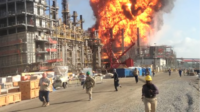Provisions of NFPA 70E® encompass safety-related work practices, safety-related maintenance requirements, and safety requirements for electrical work. The standard includes guidance for making hazard identification and risk assessments, selecting appropriate PPE, establishing electrically safe work conditions and employee training. The NFPA 70E gets updated every three years.
NFPA states that hundreds of deaths and thousands of burn injuries occur each year due to shock, electrocution, arc flash, and arc blast — and most could be prevented through compliance with NFPA 70E: Standard for Electrical Safety in the Workplace®.
Injuries from electric shock and arc flash hazards are the 6th leading cause of occupational fatality in the U.S. On average, approximately 2,000 workers each year are admitted for hospital treatment due to electrical burns.
The “Big Three”
If you're responsible for ensuring workers are protected from shock and arc flash hazards, NFPA recommends use the 2015 NFPA 70E® along with the 2014 NFPA 70®: National Electrical Code® (NEC®) and the 2013 NFPA 70B: Electrical Equipment Maintenance. Together, the “Big Three” help you protect your personnel and your company.
Work practices covered by NFPA 70E® include installation, inspection, operation, maintenance, and demolition of electric conductors, electric equipment, signaling and communications conductors and equipment, and raceways. NFPA 70E® also addresses these work activities that can expose employees to electrical hazards: installation of conductors and equipment that connect to the supply of electricity; and installations used by the electric utility, such as office buildings, warehouses, garages, machine shops, and recreational buildings that are not an integral part of a generating plant, substation, or control center.
To protect workers from electric arc threats, identify potential arc hazards in the workplace, you should confirm the potential and assess the severity of arc hazards by performing an arc hazard analysis, apply engineering solutions to reduce frequency and severity of exposure, train workers on the safe work practices and provide PPE as required in NFPA70E®.
Understanding arc hazards
Specifically regarding training, your employees must understand the nature of arc hazards and understand the safe work practices outlined in NFPA 70E®. They must also realize the importance of wearing flame-resistant (FR) protective apparel to protect against the heat of electric arc exposures.
Arc flash temperatures can reach or exceed 35,000 °F (19,400 °C) at the arc terminals. Energy released in the fault vaporizes the metal conductors involved, blasting molten metal and expanding plasma outward with massive force. A typical arc flash incident can be inconsequential but can produce a more devastating explosion. During the arc flash, electrical energy vaporizes the metal, which changes from solid state to gas vapor, expanding it with explosive force. This violent blast can destroy equipment and injure or kill not only electrical workers but also bystanders. According to the U.S. Bureau of Labor Statistics, between 1992 and 2006, an average of 283 employees died per year from contact with electric current.
Defining “qualified” & “unqualified”
NFPA 70E® requires employers to document electrical safety related training. According to 110.2(E), employers are required to document electrical safety training for qualified persons (110.2(D(1)), and for unqualified persons relating to electrical safety-related practices necessary for their safety (110.2(D)(2)).
A qualified person has received training and is skilled and knowledgeable in the construction and operation of electric equipment and installations and the hazards involved. NFPA 70E® specifically requires a qualified person to be able to demonstrate that they can properly use a voltage detector, interpret its indications, as well as understand all the limitations of each specific voltage detector in use at the employers site. The standard goes on to state that a qualified person must be proficient at all work practices set out by the employer in addition to using a voltage detector. So training must be aligned with workplace-specific practices. To remain a qualified person, retraining must occur at least every three years.
Given the performance-oriented language of the training requirements, you might consider using one of a number of electrical safety training consultancies, which offer courses to meet NFPA and OSHA qualified person requirements, and can create site-specific training. Training can take place at vendor classrooms located across the country, at your own workplace, and online.
Documentation is to be made when each employee has demonstrated proficiency in the work practices involved. It is to be maintained for the duration of the employee’s job tenure. Content of the training received, each employee’s name, and dates of training are to be included in the documentation.
Under 130.2(D)(3) you must provide additional training when: (1) supervision or the annual inspection indicates that an employee is not following required electrical safety-related work practices; or (2) when new technology or new equipment or changes in work procedures, necessitating electrical safety-related work practices that are different from those which the employee would normally use, or (3) when an employee is required to use electrical safety-related work practices that are new to them.




